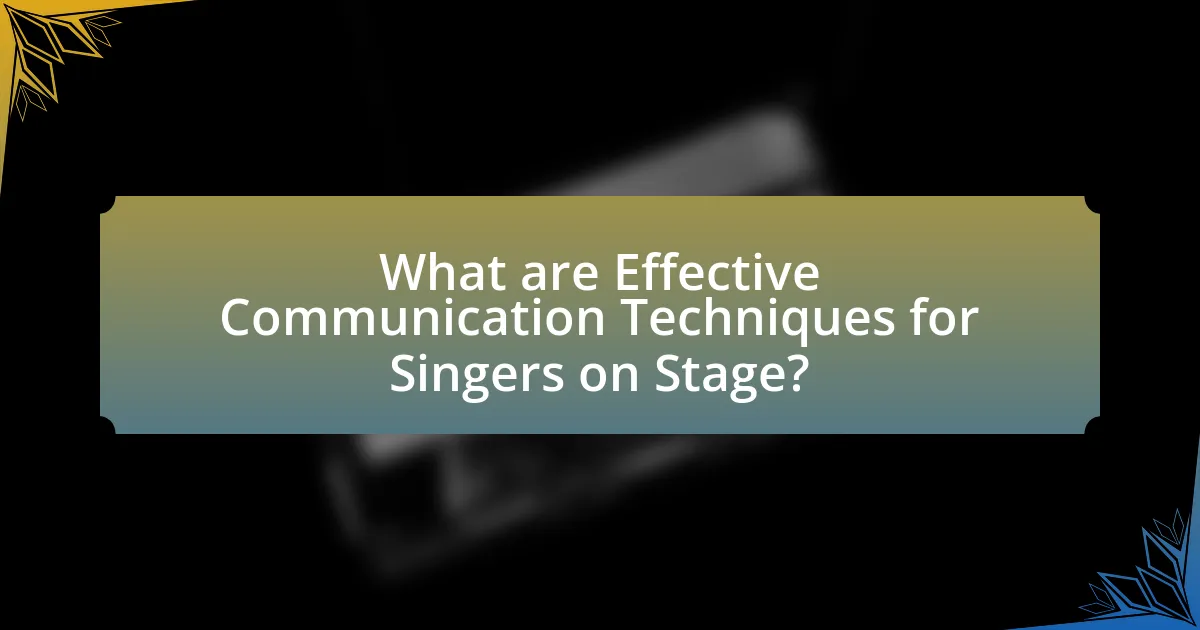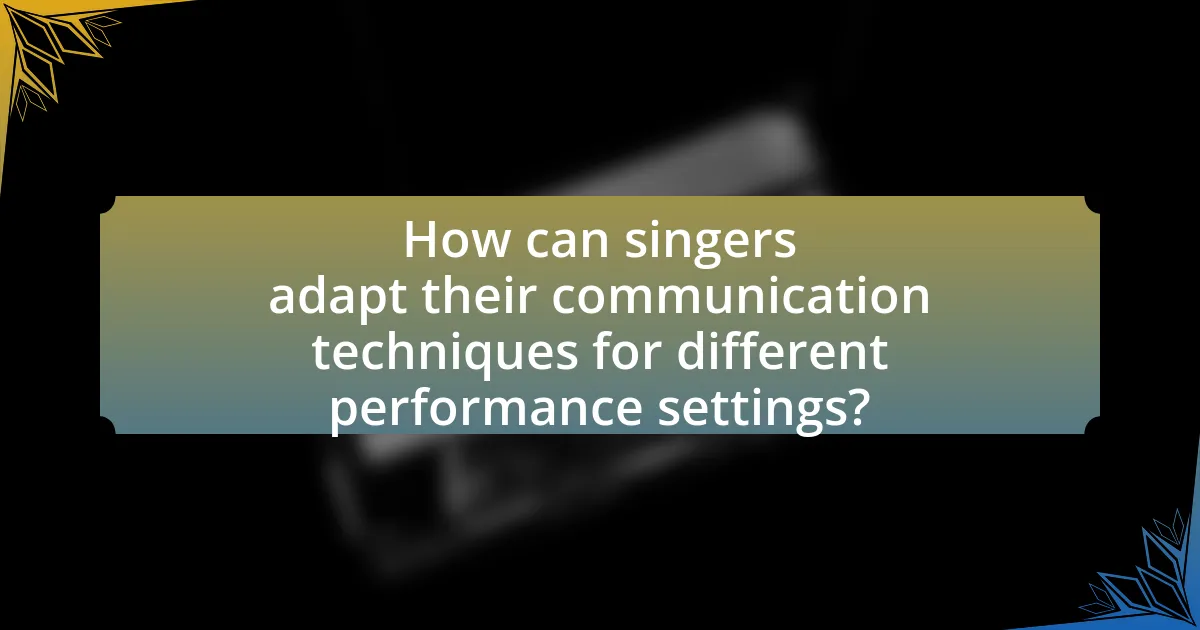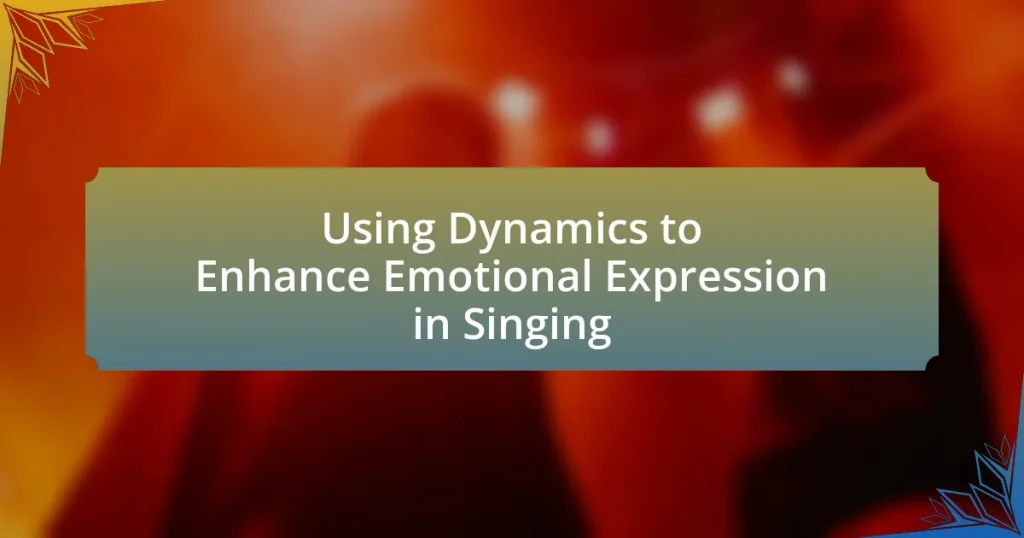Effective communication techniques for singers on stage are essential for creating a memorable performance and connecting with the audience. Key components include clear vocal delivery, engaging body language, and audience interaction, which enhance emotional expression and relatability. The article explores how these techniques improve performance quality, the significance of eye contact and vocal projection, and strategies for adapting communication styles to different venue sizes. Additionally, it addresses the role of technology and social media in enhancing audience engagement, while providing practical tips for improving stage communication and avoiding common mistakes.

What are Effective Communication Techniques for Singers on Stage?
Effective communication techniques for singers on stage include clear vocal delivery, engaging body language, and audience interaction. Clear vocal delivery ensures that lyrics and messages are understood, which is essential for connecting with the audience. Engaging body language, such as eye contact and expressive gestures, enhances the emotional impact of the performance. Audience interaction, through call-and-response or inviting participation, fosters a sense of connection and involvement. These techniques are supported by research indicating that performers who effectively engage with their audience create a more memorable and impactful experience.
How do communication techniques enhance a singer’s performance?
Communication techniques enhance a singer’s performance by fostering a deeper connection with the audience, which can lead to a more engaging and memorable experience. Effective verbal and non-verbal communication allows singers to convey emotions and narratives, making their performances more relatable. For instance, studies show that performers who utilize eye contact and body language effectively can increase audience engagement by up to 30%. Additionally, clear articulation and vocal dynamics help in delivering lyrics and emotions more powerfully, ensuring that the message resonates with listeners. This combination of techniques not only captivates the audience but also boosts the singer’s confidence, ultimately enhancing the overall performance quality.
What role does body language play in effective communication for singers?
Body language plays a crucial role in effective communication for singers by enhancing emotional expression and audience connection. When singers use gestures, facial expressions, and posture, they convey emotions that complement their vocal performance, making the message more impactful. Research indicates that nonverbal cues can account for up to 93% of communication effectiveness, highlighting the importance of body language in engaging the audience and conveying the intended message. This alignment between vocal delivery and physical expression fosters a deeper connection with listeners, ultimately enhancing the overall performance experience.
How can vocal techniques improve stage communication?
Vocal techniques can significantly enhance stage communication by improving clarity, projection, and emotional expression. Effective use of breath control allows performers to project their voices without straining, ensuring that their message reaches the audience. Additionally, varying pitch and tone can convey different emotions, making the performance more engaging and relatable. Research indicates that singers who utilize proper vocal techniques can increase audience retention and emotional response, as evidenced by a study published in the Journal of Voice, which found that expressive vocal delivery enhances listener engagement. Thus, mastering vocal techniques is essential for effective stage communication.
Why is audience engagement important for singers?
Audience engagement is crucial for singers because it enhances the emotional connection between the performer and the audience, leading to a more memorable experience. Engaged audiences are more likely to respond positively, which can increase the singer’s popularity and fan base. Research indicates that performances with high audience interaction can boost overall satisfaction ratings by up to 30%, demonstrating the tangible benefits of engagement. Additionally, engaged audiences often share their experiences on social media, amplifying the singer’s reach and visibility.
What strategies can singers use to connect with their audience?
Singers can connect with their audience by engaging in direct eye contact, using storytelling in their performances, and incorporating audience participation. Direct eye contact fosters a sense of intimacy and personal connection, making audience members feel acknowledged and involved. Storytelling allows singers to share personal experiences or emotions related to their songs, creating a deeper emotional resonance. Audience participation, such as inviting fans to sing along or respond to prompts, enhances the collective experience and strengthens the bond between the performer and the audience. These strategies are supported by research indicating that emotional engagement and interaction significantly enhance audience satisfaction and connection during live performances.
How does understanding the audience’s reactions influence a singer’s performance?
Understanding the audience’s reactions significantly influences a singer’s performance by allowing the artist to adapt their delivery in real-time. When a singer perceives positive reactions, such as applause or enthusiastic engagement, they may increase their energy and emotional expression, enhancing the overall performance. Conversely, if the audience appears disengaged or unresponsive, the singer might alter their approach, such as changing the tempo, song selection, or interaction style to recapture attention. Research indicates that performers who actively read audience cues can improve their connection and effectiveness, as demonstrated in studies on live performance dynamics, which show that audience feedback directly correlates with performer confidence and engagement levels.

What are the key components of effective stage communication?
The key components of effective stage communication include clarity, engagement, body language, and audience awareness. Clarity ensures that the message is easily understood, which is crucial for singers to convey their emotions and connect with the audience. Engagement involves interacting with the audience through eye contact and vocal variation, fostering a connection that enhances the performance. Body language plays a significant role, as it conveys emotions and intentions non-verbally, making the performance more impactful. Audience awareness allows performers to adapt their communication style based on the audience’s reactions, ensuring a more resonant experience. These components collectively enhance the effectiveness of stage communication for singers.
How can singers use eye contact to enhance their performance?
Singers can enhance their performance by using eye contact to create a connection with their audience. This connection fosters emotional engagement, making the performance more impactful. Research indicates that eye contact can increase audience perception of a singer’s authenticity and confidence, which are crucial for a memorable performance. For example, a study published in the Journal of Nonverbal Behavior found that performers who maintained eye contact were rated higher in terms of charisma and audience engagement. By strategically using eye contact, singers can convey emotions and draw listeners into the narrative of the song, ultimately elevating the overall experience for both the performer and the audience.
What techniques can singers employ to maintain eye contact with the audience?
Singers can employ techniques such as scanning the audience, using focal points, and engaging with specific individuals to maintain eye contact. Scanning involves looking across different sections of the audience to create a connection with various attendees, which helps to engage the entire crowd. Utilizing focal points, such as specific audience members or areas, allows singers to establish a sense of intimacy and connection. Engaging with specific individuals, by making eye contact with them for a moment, can create a personal bond that resonates with the audience as a whole. These techniques are supported by performance studies indicating that eye contact enhances audience engagement and emotional connection, making the performance more impactful.
How does eye contact affect the emotional connection with the audience?
Eye contact significantly enhances the emotional connection between a performer and the audience. When singers maintain eye contact, they create a sense of intimacy and engagement, making the audience feel personally involved in the performance. Research indicates that eye contact can increase feelings of trust and empathy; for instance, a study published in the journal “Psychological Science” found that direct gaze can enhance emotional responses and connection in social interactions. This connection is crucial for singers, as it fosters a shared emotional experience, allowing the audience to resonate more deeply with the music and lyrics being performed.
What is the significance of vocal projection in communication?
Vocal projection is significant in communication as it ensures that a speaker’s voice reaches the audience clearly and effectively. This ability to project one’s voice enhances the delivery of messages, making them more impactful and engaging. Research indicates that effective vocal projection can increase audience retention of information by up to 50%, as it allows for better clarity and reduces misunderstandings. Furthermore, strong vocal projection conveys confidence and authority, which can influence how the audience perceives the speaker’s credibility.
How can singers improve their vocal projection on stage?
Singers can improve their vocal projection on stage by utilizing proper breath support and vocal techniques. Breath support involves engaging the diaphragm to control airflow, which enhances volume and clarity. Techniques such as resonance tuning, where singers adjust their vocal tract shape, can amplify sound without straining the voice. Research indicates that singers who practice these methods can increase their vocal power significantly, as demonstrated in studies on vocal pedagogy that show a correlation between breath control and projection effectiveness.
What exercises can help singers develop better vocal projection?
Singers can develop better vocal projection through exercises such as diaphragmatic breathing, vocal sirens, and resonance exercises. Diaphragmatic breathing strengthens the diaphragm, allowing for better control of airflow and volume. Vocal sirens, which involve sliding through pitches, help singers explore their vocal range and improve flexibility, contributing to a more powerful sound. Resonance exercises, like humming or using “ng” sounds, enhance the singer’s ability to project their voice by focusing on sound placement and amplification in the vocal tract. These exercises are supported by vocal pedagogy principles that emphasize breath control and resonance for effective vocal projection.

How can singers adapt their communication techniques for different performance settings?
Singers can adapt their communication techniques for different performance settings by modifying their vocal delivery, body language, and audience engagement strategies. In intimate settings, such as small venues, singers often use softer vocal tones and closer physical proximity to the audience to create a personal connection. In contrast, larger venues require more projection and dynamic gestures to reach and engage a broader audience. Research indicates that effective non-verbal communication, such as eye contact and facial expressions, enhances audience connection, particularly in diverse settings. For example, a study published in the Journal of Voice found that singers who adjusted their body language based on audience size reported higher levels of audience engagement and satisfaction.
What adjustments should singers make for intimate venues versus large arenas?
Singers should adjust their vocal projection and stage presence for intimate venues compared to large arenas. In intimate settings, singers can use softer vocal techniques and more personal interactions, as the audience is closer and can hear subtle nuances. For example, a softer tone and conversational style can create a more engaging atmosphere. In contrast, large arenas require singers to project their voices more powerfully and utilize broader gestures to reach audiences spread over greater distances. This often involves amplifying their voices and using dynamic stage movements to maintain audience engagement. The necessity for these adjustments is supported by performance studies indicating that audience perception varies significantly based on venue size, with smaller venues allowing for more nuanced communication and larger venues demanding more pronounced vocal and physical expressions.
How does the size of the venue impact a singer’s communication style?
The size of the venue significantly impacts a singer’s communication style by influencing their vocal projection, body language, and audience engagement techniques. In larger venues, singers often need to project their voices more powerfully and use broader gestures to reach audiences seated far away, while in smaller venues, they can adopt a more intimate and conversational style, utilizing softer vocal tones and subtle movements. Research indicates that performers adapt their communication strategies based on audience size to maintain connection and engagement, as evidenced by studies showing that audience perception of performance quality varies with venue size, necessitating different approaches to effectively convey emotion and connect with listeners.
What specific techniques work best in smaller settings?
In smaller settings, techniques such as direct eye contact, active listening, and personalized interactions work best for effective communication. Direct eye contact fosters a connection with the audience, making them feel engaged and valued. Active listening allows singers to respond to audience reactions in real-time, enhancing the overall experience. Personalized interactions, such as addressing audience members by name or acknowledging their presence, create a more intimate atmosphere, which is crucial in smaller venues. These techniques are supported by research indicating that personal engagement significantly improves audience satisfaction and connection during performances.
How can technology aid in effective communication for singers?
Technology aids in effective communication for singers by providing tools that enhance vocal clarity and audience engagement. For instance, wireless microphones allow singers to move freely on stage while maintaining sound quality, ensuring that their voice is heard clearly. Additionally, digital audio workstations enable real-time sound mixing, allowing singers to adjust their vocal levels and effects during performances, which enhances the overall auditory experience. Furthermore, visual aids such as screens displaying lyrics or cues can help singers connect with their audience and stay in sync with the performance, thereby improving communication. These technological advancements have been shown to increase audience satisfaction and engagement, as evidenced by studies indicating that clear sound and visual elements significantly enhance live performance experiences.
What tools can singers use to enhance their stage presence?
Singers can use various tools to enhance their stage presence, including body language, vocal dynamics, and audience engagement techniques. Body language, such as purposeful movements and facial expressions, helps convey emotions and connect with the audience. Vocal dynamics, which involve varying pitch, volume, and tone, can create a more engaging performance. Additionally, techniques like eye contact, call-and-response interactions, and storytelling can foster a deeper connection with the audience, making the performance more memorable. Research indicates that effective use of these tools can significantly improve audience perception and enjoyment of live performances.
How can social media be leveraged for better audience interaction?
Social media can be leveraged for better audience interaction by utilizing platforms to engage directly with fans through live Q&A sessions, polls, and behind-the-scenes content. These interactive features foster a sense of community and personal connection, which is essential for artists. For instance, a study by the Pew Research Center found that 69% of adults in the U.S. use social media, indicating a vast audience that can be reached effectively. Engaging content, such as Instagram Stories or Twitter polls, encourages audience participation and feedback, enhancing the overall interaction experience.
What are some practical tips for improving communication on stage?
To improve communication on stage, singers should focus on clear vocal delivery, engaging body language, and audience interaction. Clear vocal delivery ensures that lyrics and messages are understood, which can be enhanced by practicing enunciation and projection techniques. Engaging body language, such as maintaining eye contact and using gestures, helps convey emotions and connect with the audience. Audience interaction, through call-and-response or inviting participation, fosters a sense of inclusion and enhances the overall experience. These strategies are supported by studies indicating that effective non-verbal communication significantly impacts audience engagement and perception during performances.
How can rehearsal techniques enhance a singer’s communication skills?
Rehearsal techniques can significantly enhance a singer’s communication skills by fostering a deeper understanding of lyrical content and emotional expression. Through consistent practice, singers learn to convey the intended message of a song more effectively, which is crucial for audience engagement. For instance, techniques such as role-playing and emotional visualization allow singers to connect personally with the material, thereby improving their ability to express emotions authentically. Research indicates that singers who engage in structured rehearsals demonstrate improved non-verbal communication skills, such as body language and facial expressions, which are essential for captivating an audience. This enhancement in communication skills ultimately leads to a more impactful performance, as singers become adept at conveying both the narrative and emotional nuances of their music.
What common mistakes should singers avoid in stage communication?
Singers should avoid common mistakes in stage communication such as failing to engage with the audience, neglecting body language, and not maintaining eye contact. Engaging with the audience is crucial; when singers ignore their listeners, they miss the opportunity to create a connection, which can diminish the overall performance impact. Additionally, poor body language, such as closed-off postures or lack of movement, can convey disinterest or insecurity, detracting from the performance. Lastly, not maintaining eye contact can make the performance feel impersonal, as it prevents the establishment of a rapport with the audience. These mistakes can significantly hinder a singer’s ability to communicate effectively on stage.














